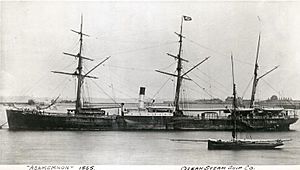SS Agamemnon (1865) facts for kids
class="infobox " style="float: right; clear: right; width: 315px; border-spacing: 2px; text-align: left; font-size: 90%;"
| colspan="2" style="text-align: center; font-size: 90%; line-height: 1.5em;" | 
|}
The SS Agamemnon was a very important steamship. She was one of the first ships that could travel long distances using steam power. Built in 1865, her job was to carry goods and people between Britain and China.
Before Agamemnon, steamships weren't great for long trips. They needed to carry so much coal that there wasn't much room left for cargo. But Agamemnon was different! She could travel at 10 knots (19 km/h) (about 18.5 km/h) and only used 20 tons of coal each day. This was a huge saving compared to other ships. It meant she could reach China with just one stop for coal in Mauritius.
Agamemnon was named after Agamemnon, a famous king from ancient Greek stories. She was the first of five ships from the Blue Funnel Line to carry this name. One later ship, built in 1929, was even used in World War II to lay mines in the sea.
Contents
| History | |
|---|---|
| Name | Agamemnon |
| Namesake | Agamemnon |
| Owner | Ocean Steam Ship Co |
| Operator | |
| Port of registry | Liverpool |
| Route | Liverpool to China and the Far East |
| Builder | Scott & Co, Greenock |
| Yard number | 116 |
| Launched | 6 October 1865 |
| Identification | |
| Fate | Scrapped 1898 |
| General characteristics | |
| Type | cargo and passenger steamship |
| Tonnage | 2,270 GRT, 1,550 NRT |
| Length | 309.3 ft (94.3 m) |
| Beam | 38.8 ft (11.8 m) |
| Depth | 20.6 ft (6.3 m) |
| Installed power | 300 hp |
| Propulsion |
|
| Sail plan | 3-masted barque |
| Speed | 10 knots (19 km/h) |
Building a Better Ship: The Agamemnon Story
Agamemnon was the first of three similar ships. Her sisters were named Achilles (built in 1866) and Ajax (built in 1867). All three were built by Scott & Co in Greenock, Scotland. They were made for the Ocean Steam Ship Company, which later became the famous Blue Funnel Line. Each ship was about 2,270 GRT gross tons and 1,550 NRT net tons. They were also about 309 feet (94 m) (94 meters) long and 38 feet (12 m) (11.6 meters) wide.
Three Key Ideas for Success
Agamemnon and her sister ships were special because they combined three new ideas:
- Higher Boiler Pressure: Most British merchant ships used low boiler pressure. But Alfred Holt, who owned the company, tried a higher pressure of 60 psi (pounds per square inch). He convinced the authorities that it was safe for ships at sea.
- Efficient Engine: Alfred Holt also designed a special compound steam engine. It used fuel much more efficiently than other engines of the time. Plus, it was smaller, which meant more space for cargo!
- Strong, Light Hull: The ship's body, or hull, was made of iron. It was designed by Alfred Holt to be very strong but also light. This meant the ship didn't need as much power to move through the water.
These improvements made Agamemnon very fuel-efficient. She could travel from London to Mauritius, a journey of 8,500 miles (about 13,700 km), without needing to refuel. This was about half the distance to China around the Cape of Good Hope.
Faster Than Sailing Ships
Agamemnon's amazing fuel efficiency helped her compete with fast sailing ships called clippers. These clippers were famous for carrying tea from China to Britain.
Agamemnon could travel from Fuzhou, China, to Liverpool, England, in just 58 days. Tea clippers, on the other hand, took much longer. Their fastest trip was 88 days, but they often took 140 days or more. On average, they took 123 days in 1867–68. Plus, Agamemnon could carry two or three times more cargo than a clipper!
Scott & Co. built Agamemnon as yard number 116. She was launched into the water on November 25, 1865, and finished on March 31, 1866. Alfred Holt registered her in Liverpool. Her official UK number was 54924, and by 1871, her code letters were JKGB.
Agamemnon's First Big Trip
The brand new Agamemnon arrived in Liverpool on April 1, 1866. This was the same year as the famous Great Tea Race between clippers. She set sail for China on April 19.
Her first journey was super fast! She reached Mauritius in just 40 days and Singapore in 60 days. The entire trip from Liverpool to Hong Kong took only 65 days. This was much faster than the quickest tea clipper trip, which was 77 days by the Cairngorm in 1853.
Later Journeys and a Big Change
In 1869, something very important happened: the Suez Canal opened. This canal made a huge difference for steamships. It created a much shorter route from Europe to China. Sailing ships, however, still had to go the long way around the Cape of Good Hope.
The Suez Canal guaranteed the success of Agamemnon and her sister ships. In just a few years, tea clippers lost their lead in the China trade. Other companies started building similar steamships. This marked a major change in how long-distance trade was done around the world.
The End of Her Journey
In 1897, Agamemnon was moved to a Dutch company owned by Alfred Holt. She was taken apart for scrap in 1899, ending her long and successful career.

